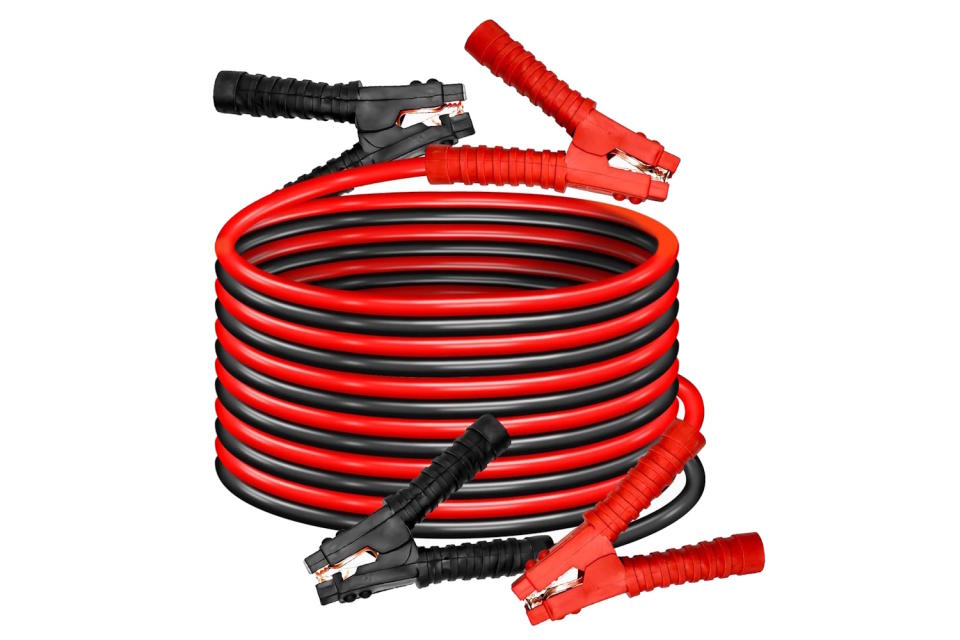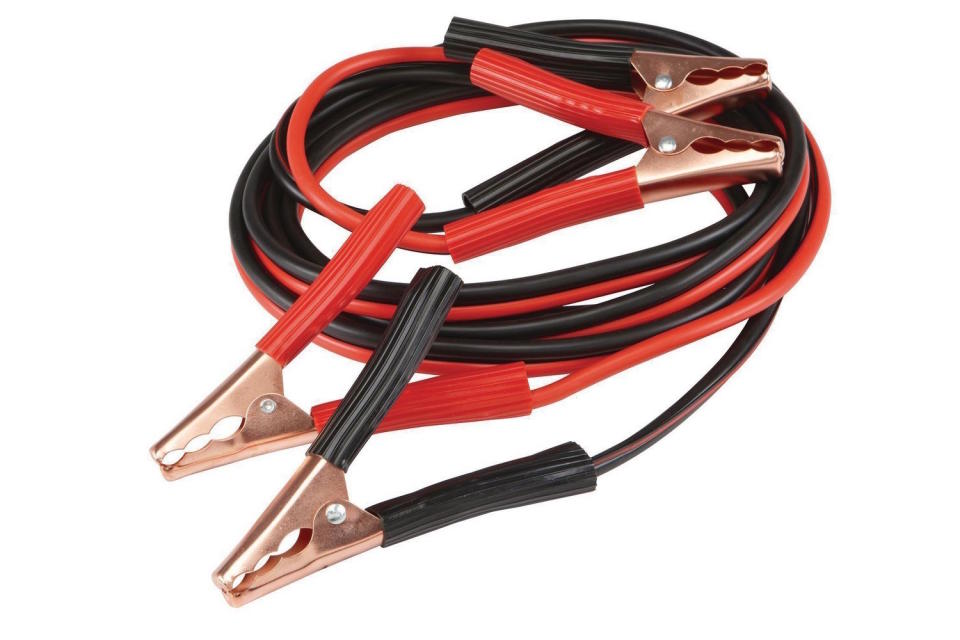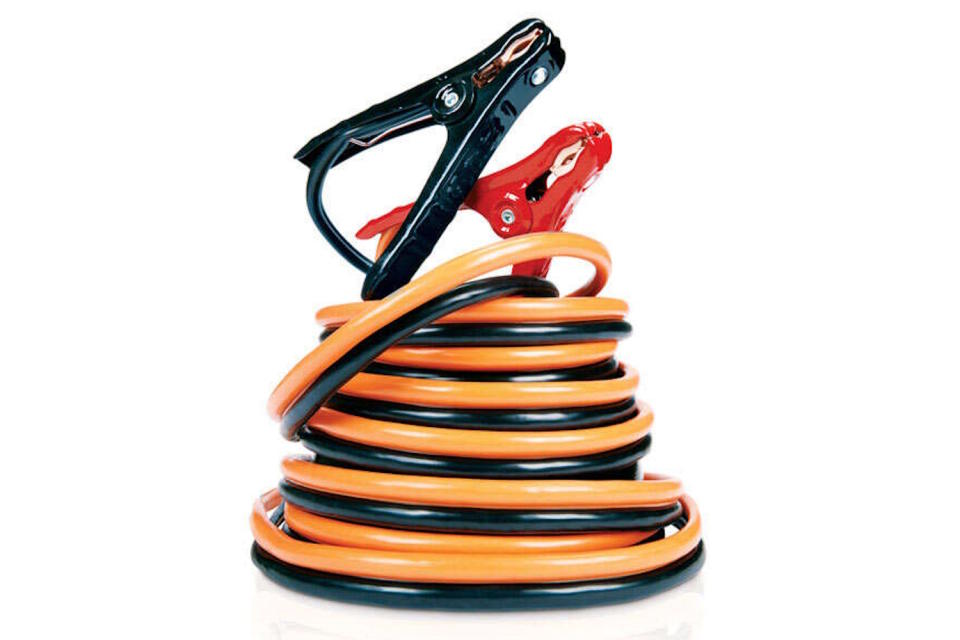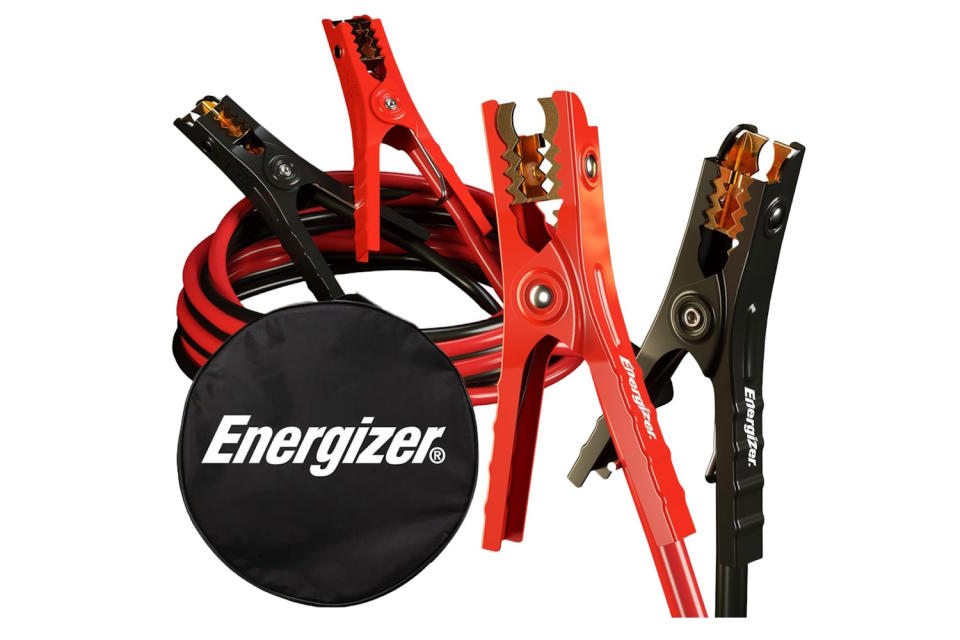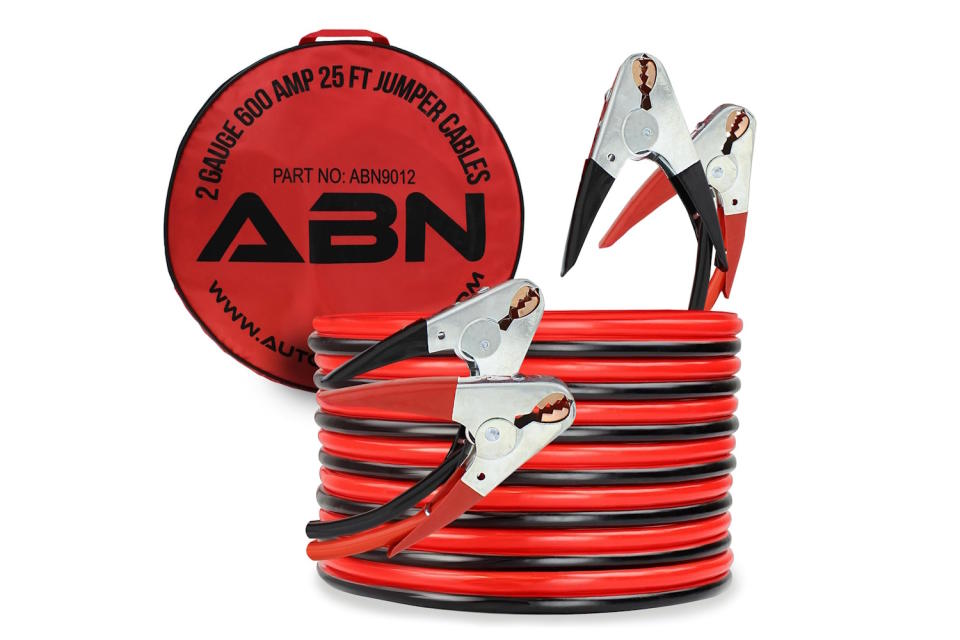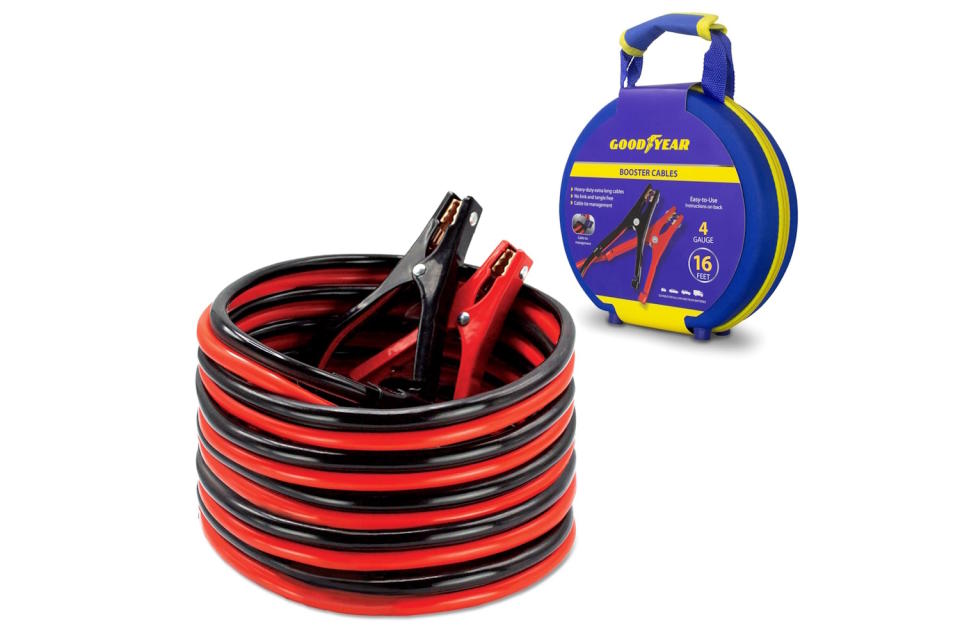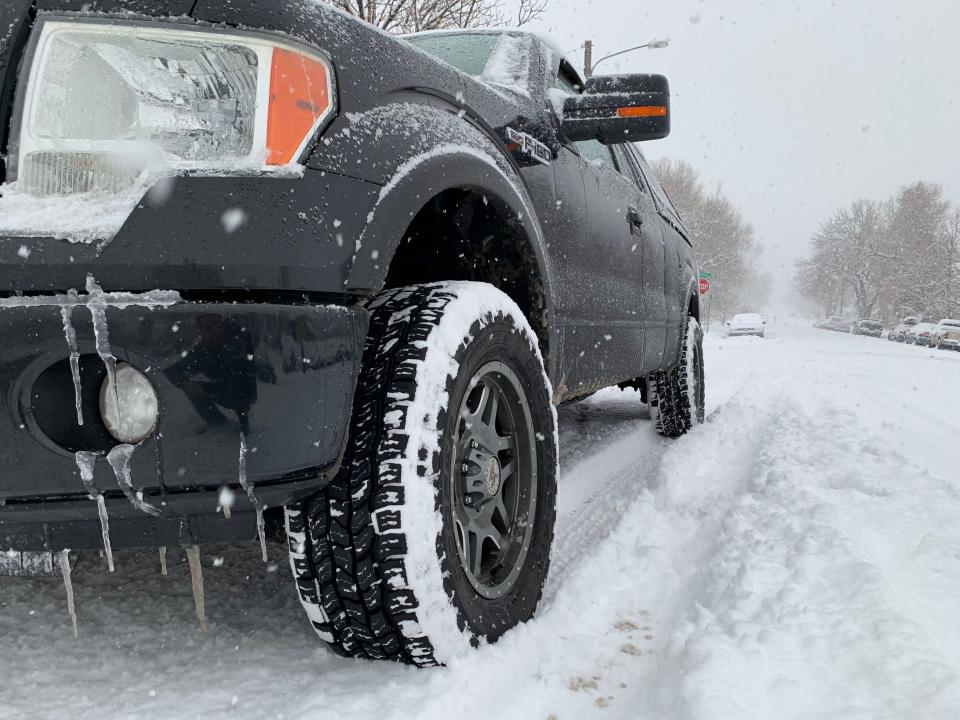The Best Jumper Cables of 2024
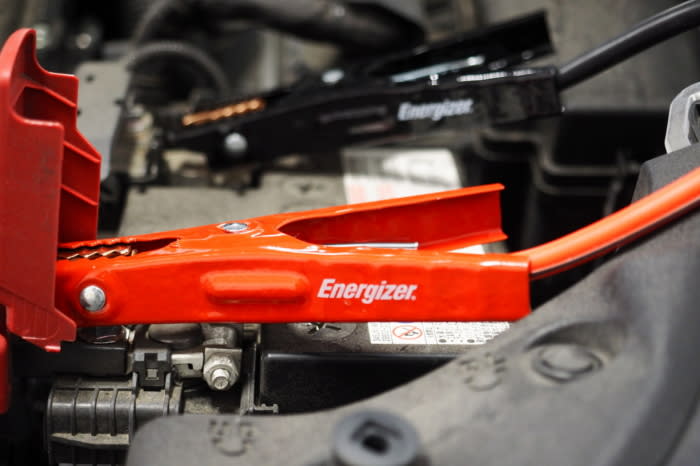
It happens to the best of us sometimes. You accidentally leave your headlights on, your battery loses its charge, and you need to jumpstart your vehicle. Or you have a vehicle battery older than 4 years, and it’s not up to the task of holding a charge for too long.
Or, you live in a really cold environment and don’t drive your vehicle for adequate periods to recharge the battery: Those variables stack up. Either way, you should have a good set of jumper cables to jumpstart your car safely.
Jumper cables are a lifesaver when your car fails to start due to a weak or dead battery. These cables enable you to connect your vehicle’s battery to another power source, typically another vehicle’s battery, to give it an instant power boost. By transferring electrical energy from the working battery to the dead one, jumper cables allow you to start your car and carry on with your journey without delay.
A quality set of booster cables will get your vehicle started and on your way. The best jumper cables in your emergency kit allow you to bypass the wait for roadside assistance or a tow truck.
Shopping for a set of jumper cables shows an overwhelming number of choices with different price points, capabilities, and quality grades. Based on our hands-on testing, the quality built into the materials and construction, and customer feedback, we compiled a list of the best jumper cables deemed worthy of getting you or some unlucky person out of a jam.
In worst-case scenarios, when your vehicle’s battery continually falters and cannot hold a charge, it might be time for a new one. Bring the battery to a local auto parts store or service center and ask them to test it for dead or weakened cells — especially if it is over 4 years old.
To learn more about jumper cables and a more in-depth analysis of how they can vary, check out our comprehensive buyers guide, FAQ, and comparison chart below.
The Best Jumper Cables of 2024
Best Overall Jumper Cables: VIKING 20 ft. 2 Gauge Super Heavy Duty Jumper Cables
Best Budget Jumper Cables: PITTSBURGH AUTOMOTIVE 12 ft. 10 Gauge Jumper Cables
Best Premium Jumper Cables: Diehard Advanced Power Booster Cable 71303
Best Practical Choice Jumper Cables: Energizer 6 Gauge Jumper Cables
Best for Unplanned Emergencies: ABN Jumper Cables, 25 ft, 2 Gauge, 600 Amp
Best Overall Jumper Cables
Best Overall Jumper Cables
VIKING 20 ft. 2 Gauge Super Heavy Duty Jumper Cables
Specs
Size 2 gauge
Amp rating 420 A
Length 20 ft.
Carrying bag included Yes, a case
Pros
Commercial-grade suitable for cars, trucks, and marine vehicles
Tangle-free flexibility in cold and warm weather
PVC jacket water-, oil-, and chemical-resistant
Cons
Big and bulky
The VIKING 20 ft. 2 Gauge Super Heavy Duty Jumper Cables ($40) can deliver up to 420 A, allowing you to start SUVs, trucks, buses, or boats in seconds. At a generous 20 feet, these cables take away the hassle of aligning vehicles hood-to-hood. The 2-gauge stranded copper wire ensures they remain cool during operation and resist tangling.
The alligator clamps’ copper-coated jaws have a secure grip and are designed for top- and side-mounted battery terminal posts. Because of the spring’s gorilla-grip tension, you’ll need strong hand muscles to open them. We tested the booster cables with several cars and trucks and liked the clamping action, even in awkward situations.
Freezing temperatures can weaken a battery by 30% or more. If a car or truck needs a jump start during the winter, the Viking Super Heavy Duty Jumper Cables will stay flexible in cold, harsh weather. The PVC jacket makes it easier to coil up the cables for storage in the included plastic hard case and protect it against oil and corrosive chemicals.
Of course, the sum of all these quality features comes at a small cost. The first is the bulkiness of this cable set. A thick protective jacket, made of thermoplastic material and designed for extremely low temperatures, wrapped around 20 feet of 2-gauge copper-clad aluminum wire, adds up to 6.1 pounds. The second is the suggested retail price of $40, which isn’t overly expensive but definitely above average for a set of jumper cables.
VIKING 20 ft. 2 Gauge Super Heavy Duty Jumper Cables are a good choice due to their quality, efficiency, and clamp design. They have several advantages that amount to a commercial-grade product designed for many years of use and robust enough to handle the big-boy jobs. A nice extra is the included plastic hard case for convenient storage.
$35 at AmazonCheck Price at Harbor Freight Tools
Best Budget Jumper Cables
PITTSBURGH AUTOMOTIVE 12 ft. 10 Gauge Jumper Cables
Specs
Size 10 gauge
Amp rating 150 amps
Length 12 ft.
Carrying bag included Yes
Pros
Copper-coated aluminum cable and copper-coated steel clamps
Flexible and easy to store and tuck away
Use Harbor Freight coupons for more savings
Cons
Capacity suitable primarily for small to midsize cars, trucks, and crossovers
Only 12 feet of reach
Low-quality insulation used on clamps
We’re not surprised the PITTSBURGH AUTOMOTIVE 12 ft. 10 Gauge Jumper Cables ($10) are a popular item at Harbor Freight: They are an outstanding choice for jumpstarting your car or another disabled vehicle in rare emergencies. This booster cable set has the right mix of quality, capability, and value that won’t incite a long string of swear words when used.
These 10-gauge cables will work brilliantly when jumpstarting small to midsize cars and trucks but are not ideal for bigger vehicles (e.g., buses, RVs, freight trucks) that require more starting power. Our tests showed that electrical current efficiently passes through these booster cables but slightly warms up when handling heavy loads and big engines. The insulation on the handle grips appears subpar and doesn’t exude quality.
The 12-foot length is only ideal for some situations, but it is the least expensive of our choices. Optimally, it requires that the donor vehicle and the one that needs assistance be positioned relatively close to each other. However, these are just the right size for keeping in the car and only take up minimal space when packed in the included storage bag.
Collectively, the PITTSBURGH AUTOMOTIVE 12 ft. 10 Gauge Jumper Cables have a price tag that will please even the most budget-conscious buyer — without compromising on quality where it counts. The price gets even better if you take advantage of a Harbor Freight coupon or promotion.
Best Premium Jumper Cables
Diehard Advanced Power Booster Cable 71303
Specs
Size 6 gauge
Amp rating 225 A
Length 16 ft.
Carrying bag included No
Pros
Electrical performance enables quick jumpstarting of vehicles
Clamp design offers the best performance and secure grip
PVC jacket oil- and chemical-resistant
Cons
Premium price point
A sturdy all-around, the Diehard Advanced Power Booster Cable 71303 ($42) set is from a highly recognized brand name at a premium price. It offers a quick fix in times of dire need and a great combination of features that most drivers need when they need a boost to get going again.
Thick, 6-gauge copper-clad aluminum wire provides excellent conductivity without overheating compared to thinner cables and is not prone to tangling. The cables remain flexible in cold weather and are rated for sub-zero temperatures. As a test, we stuffed the Diehard booster cables into a freezer for a few hours and verified that they remained pliable.
The booster cable clamps are perfect for batteries with top- or side-mounted battery posts. The fully insulated clips and high-quality copper and aluminum jaws will keep your hands safe from current while connecting the cable.
Our test period was only about 3 months. Still, we didn’t see any problems, such as corrosion, weakening clamp springs over time, cables separating, or the ability to jumpstart large vehicles. Nonetheless, heavier gauge jumper cables with a higher amp rating are available at the same or lower price point.
To sum up, the Diehard Advanced Power Booster Cable 71303 offers a premium solution for drivers seeking a reliable jumpstart option. Its sturdy construction, including thick 6-gauge wire and high-quality clamps, ensures excellent conductivity and durability. The cables’ ability to remain flexible in cold weather and their resistance to tangling are significant advantages. While the price may be on the higher end, the peace of mind and performance offered by these cables make them a worthwhile investment for those needing a dependable jumper cable solution.
Best Practical Choice Jumper Cables
Energizer 6 Gauge Jumper Cables
Specs
Size 6 gauge
Amp rating N/A
Length 16 ft.
Carrying bag included yes
Pros
Strong alligator clamps with copper-coated teeth
Copper-clad aluminum cables
A protective, thick vinyl wire jacket stays flexible at extreme cold temperatures
Available in different gauges and lengths
Cons
6 gauge is not ideal for large engines
The thin vinyl carrying case will not last too many years
Reasonably priced, mid-range cable thickness, 16-foot length, and insulated alligator clamps with a muscular grip make the Energizer 6 Gauge Jumper Cables ($20) the Goldilocks choice. And the price makes it easy to justify having a reliable lifeline in the emergency kit — whether they get used or not.
The vinyl-coated alligator clamps have a firm grip, and the copper-coated teeth attach to a battery terminal from the side or on top. We like that the handles are long enough for ample leverage when opening and how the jaws open wide enough to grip any size battery terminal. Our one reservation is when this jumper cable needs to be vertically attached to a battery terminal. The surface area of the serrated tooth is small and does not offer much for holding onto the battery terminal when clamped vertically, so it is a little sketchy.
For those who experience cold, harsh winters, the 6-gauge copper-clad aluminum wire will remain flexible even at temperatures below freezing. Another quality is a thick jacket wrapped around the wire to protect it against chemicals, oil, and other nefarious liquids.
While jumper cables are typically lightweight, their storage sometimes poses challenges. They often tangle, and the clamps may snag other items, causing an inconvenience. Fortunately, the included storage bag with the Energizer 6 Gauge Jumper Cables solves that problem.
While the convenient storage bag keeps things tidy, we believe the thin vinyl material will eventually dry and crack after baking in a hot car for a few summers. It is also a challenge to get the cables back into the bag. On a positive note, Energizer backs up its jumper cables with a 2-year hassle-free warranty.
Best for Unplanned Emergencies
ABN Jumper Cables, 25 Ft., 2 Gauge, 600 Amp
Specs
Size 2 gauge
Amp rating 600A
Length 25 ft.
Carrying bag included No
Pros
Commercial grade suitable for cars, trucks, and marine vehicles
Tangle-free flexibility in cold and warm weather
PVC jacket oil- and chemical-resistant
Cons
The clamp is not fully insulated, which may be a shock and short-circuit hazard
Big and bulky
When you need to start full-size trucks, SUVs, or other large, heavy-duty vehicles, the ABN Jumper Cables, 25 ft, 2 Gauge, 600 Amp ($39) are robust enough. The 600A rating is more than enough to bring almost any size dead battery back to life. It also means they can quickly crank a powerful 3L diesel engine without needing to rev the source engine.
Along with its high current capacity, we liked how the easily bendable wire remained flexible even in cold temperatures, making it a reliable backup option year-round. A few hours in the freezer confirmed the cables remain flexible at temps cold enough to make ice cubes.
No one has ever said, “I wish these booster cables were shorter.” And sometimes, parking the donor vehicle close to the stranded one is not an option.
Sometimes, parking isn’t an option. The 25-foot cable length will reach pretty far and removes the limitation of having the cars bumper-to-bumper or side-by-side with the car that needs the jump start. Longer jumper cables are good for situations where the donor vehicle can only pull up behind the stranded car if stuck on a busy highway or in a tight space.
While the parrot-style clamps have less gripping area than alligator-style clamps, they have more clearance in tight spaces, such as the case with smaller cars and crossovers. However, the clamps are not fully jacketed or insulated, and the exposed ends are a potential short-circuit or spark hazard.
Overall, the ABN Jumper Cables, 25 ft, 2 Gauge, 600 Amp package offers consistent performance, feel extremely durable, and remain cool even during intense operation. Overall, the ABN Jumper Cables, 25 ft, 2 Gauge, 600 Amp package offers consistent performance, feels extremely durable, and remains cool even during intense operation.
Best of the Rest
Goodyear 4-Gauge 16-Ft. Booster Cables
Specs
Size 4 gauge
Amp rating N/A
Length 16 ft.
Carrying bag included Yes, a hard case
Pros
Suitable for all cars and trucks
Strong solid copper parrot clamps
Tangle-free design
Cold-weather flexibility
Cons
Clamps have limited grip and opening width
The storage case is too small
Goodyear is a trusted brand for tires, but do their booster cables live up to expectations? A few months of testing convinced us that the Goodyear 4 Gauge 16-foot booster cables ($39) won’t disappoint you when called upon to jumpstart your car.
Without overheating, 4-gauge copper-coated aluminum wire can carry enough current to start most cars, light-duty trucks, crossovers, and SUVs. If you’re thinking of jumpstarting a bus or RV, we recommend using a set of 0- or 1-gauge booster cables. Their 16-foot reach will work in most emergencies. Goodyear offers these cables at a 20-foot length if you truly want to be prepared.
The freezer test proved that the Goodyear jumper cables remain flexible at frigid temperatures and can be rolled up easily for storage.
These alligator clamps open wide enough to attach to various battery posts and connectors. Clamp teeth at the front and sides of the clamp will grab top-mount and side-mount battery terminals. However, the grip strength and shape of the teeth don’t grab small battery cable terminals very well. The handles have a vinyl coating to prevent rusting and unintentional arcing or sparks.
It is challenging to fit the Goodyear 4 Gauge 16-foot booster cables back into the blue and yellow carrying case because it is about 9 inches in diameter. However, the Goodyear jumper cables include an attached cable tie to keep them tidy, and the case’s compact size makes for efficient storage.
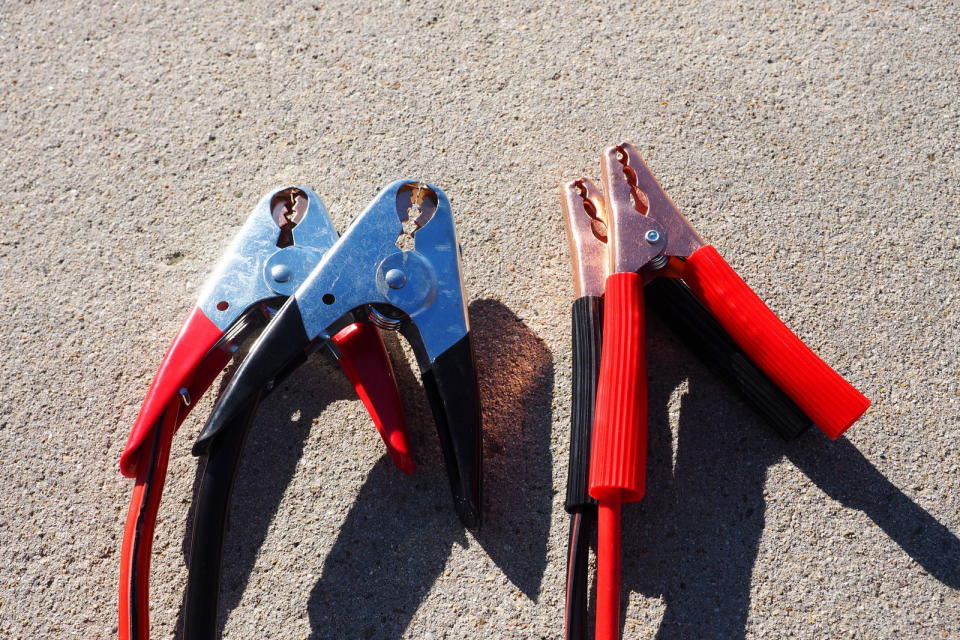
Jumper Cables Comparison Chart
Scroll right to view all of the columns: Price, Size, Amp rating, Length, Carrying bag included.
Jumper Cable | Price | Size | Amp rating | Length | Carrying bag included |
|---|---|---|---|---|---|
$40 | 2 gauge | 420 amps | 20 ft. | Yes, a case | |
$10 | 10 gauge | 150 amps | 12 ft. | Yes | |
$42 | 6 gauge | 225 amps | 16 ft. | No | |
$20 | 6 gauge | NA | 16 ft. | Yes | |
$39 | 2 gauge | 600 amps | 25 ft. | No | |
$39 | 4 gauge | NA | 16 ft. | Yes, a hard case |
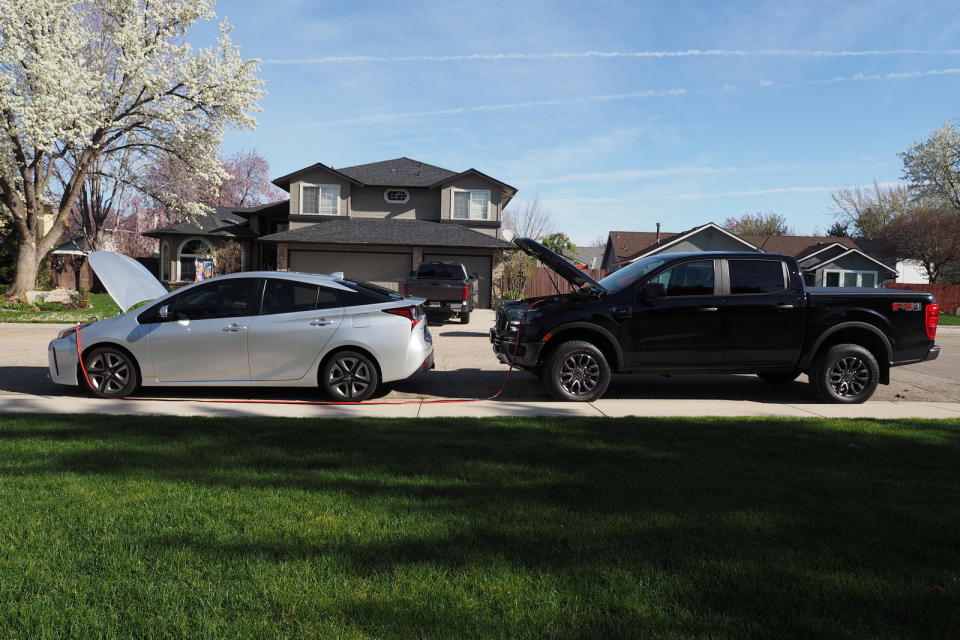
How We Tested Jumper Cables
Jumper cables are not a complicated tool or accessory. The essential parts are the clamps, the cable wire, and how well the cable is attached to the clamps. For this guide, we did a close visual inspection, a voltage drop test, a load test, and resistance measurements with a multimeter.
The visual inspection covered the clamps, how well the cables were connected to them, the cables’ flexibility, and the quality of the cable housing.
A voltage test was done by connecting the booster cables to a DC power source and measuring the voltage drop across the wires. If the voltage changed, that indicated resistance in the cable, which could affect the performance.
An ohmmeter resistance test showed if the cable was properly carrying the current. Minimal resistance means the jumper cables are in good shape. Too much resistance indicates that the cable is not adequately conducting the current.
Our automotive specialist and lead tester of this buyer’s guide, Derek Mau, curated the collection. A regular work day for Derek involves testing almost anything on four wheels, obsessively researching and shopping for the best deal, and writing detailed and informative reviews of all things automotive for GearJunkie.
A variety of jumper cables are featured in this guide for different vehicles and applications, from emergency kit staples to commercial-grade quality. In between, there are several choices for folks who want safe, reliable jumper cables for their car, truck, SUV, or any vehicle with a battery that needs a helping boost to get started.
Buyers Guide: How to Choose the Best Jumper Cables
Jumper cables, also commonly referred to as “booster cables,” come in varying degrees of quality, lengths, and details, so you’ll want to make sure you pick the pair that’s right for you.
Wire Diameter
An essential component to consider in jumper cables is the gauge, or thickness, of the wire.
The lower the gauge number, the thicker the wire, which ranges from 1-gauge to 12-gauge. Thicker — or heavy-duty — wires allow more electrical current to pass through.
So, if you have a larger vehicle battery that needs more cold cranking amps to start, you’ll probably want a pair of cables with a lower gauge number. For instance, the VIKING 20 ft. 2 Gauge Super Heavy Duty Jumper Cables set uses 2-gauge wire and is capable of starting big diesel engines in buses or RVs.
The cold cranking amps needed to start smaller vehicles are less than those required for a truck, SUV, or full-size car with a V-8 (or larger) engine. Hence, 8- or 10-gauge jumper cables are sufficient for compact cars, midsize sedans, and up-to-midsize trucks and crossovers. A good example is the PITTSBURGH AUTOMOTIVE 12 ft. 10 Gauge Jumper Cables.
Bigger vehicles with larger engines — for example, full-size trucks, SUVs, and large sedans —understandably need more power and cables of 2- to 6-gauge, like the Energizer 6 Gauge Jumper Cables that uses 6-gauge wire to carry the current without overheating.
Terminal Clamps
Booster cables can have alligator or parrot clamps. An alligator clamp has two rectangular-shaped opposing sides, and some designs have a silhouette of sharp teeth on the inside. The arching profile of a parrot clamp looks like the smooth, curved beak of a parrot with a point on the end. Inside, the clamp can still have a jagged edge that looks like shark teeth.
Overall, the outline of an alligator clamp looks slightly more linear, like a triangle, with a more pointed end. A parrot clamp is a tad more rounded.
Alligator clamps work well when connecting to battery terminals positioned at the top or side of a 12V battery. Plus, if the jaws have teeth on the top and the inside, they can grab the battery terminal in multiple positions. Parrot clamps are handy when connecting to top post terminals or when space is tight around the battery terminals.
It’s also vital that your cables have insulated clamps with a meaty grip. The attachment point is essential for conducting electricity. Hence, jumper cable clamps should be securely attached, insulated to prevent electrocution and injury, and strong enough to grip the terminal post without slipping off.
Cable Length
The conditions under which you use them will determine the length of the jumper cables. Since it is hard to imagine when and where you’ll have to use the booster cables, 12-20 feet will work in most scenarios.
A longer length will allow more distance between vehicles in areas with high traffic and limited parking choices. A good example that will have the reach for almost any situation is the ABN Jumper Cables, 25-foot, 2 Gauge, 600 Amp that stretch 25 feet — longer than a full-size truck or SUV.
Wire Composition
The purpose of jumper cables is to conduct electricity from a donor power source to a tired or weak battery that cannot start a vehicle. Copper is one of the best conductors of electricity, but the disadvantages of using pure copper wire are cost, weight, and strength.
A cost-effective solution is to use copper-clad or copper-coated aluminum wire. Although it has a lower level of electrical conductivity than solid copper wire, it will still carry plenty of juice to revive a dead battery. Two of the best examples we tested that use copper-coated aluminum wire are the Goodyear 4 Gauge 16-foot booster cables and VIKING 20 ft. 2 Gauge Super Heavy Duty Jumper Cables.
Value of Jumper Cables
The amount of money you spend on a set of jumper cables will influence your buying decision. While a budget-priced cable set might fit your allowance, better solutions may be available when your car is distressed and needs a jumpstart.
Fortunately, a wide array of models and prices offer distinctive benefits, for example, the jumper cables from Pittsburgh Automotive and Energizer: the PITTSBURGH AUTOMOTIVE 12-foot 10 Gauge Jumper Cables and the Energizer 6 Gauge Jumper Cables.
Some jumper cables include a case, whether soft or firm, and certain designs are longer than others or have a higher gauge.
How to Safely Jumpstart Vehicles
The first step can be intimidating if you’re unfamiliar with jumpstarting a rig. Especially if it’s cold outside, you’ll need to reboot fast: It’s no joke when temps hit the negatives and GearJunkie Senior Editor Morgan Tilton needs a jumpstart in Crested Butte, Colo. (She always has a pair of winter mittens in her truck).
Here’s a full rundown of the steps you’ll follow to get on the road again:
Position the two vehicles close enough — but not touching each other — so that the jumper cables reach from the donor battery to the one that needs help.
Look at the battery and identify the positive and negative terminal posts. The positive side typically has a red cable and a “+” symbol. The negative side has a black cable attached and is marked with a “-” symbol.
Correctly hooking up the cables will ensure a safe and steady current flow from the donor car to the weak or dead battery.
The jumper cables have four clamps — two at each end. Red clamps attach to the positive terminal, and black clamps attach to the negative post or ground point. Attach the red clamp of one end of the jumper cable to the dead battery’s positive terminal. Leave the black clamp unattached for now.
Attach the red clamp to the positive terminal at the good battery, and then connect the black clamp to the negative post.
Return to the vehicle that needs a boost and connect the black clamp to a bare metal, solid ground point in the engine bay, such as a metal bracket attached to the engine block away from a fuel line or an unpainted strut tower bolt. Using a ground point instead of the negative battery post avoids potentially dangerous sparks.
Start the vehicle with the good battery and let it run for about 2 minutes to charge the dead or weak battery.
Start the car with the dead battery and allow it to run for approximately 2 minutes to allow it to recharge.
Disconnect cables in reverse order, starting with the negative cable clamped to bare metal in the engine bay. Do not let the clamps touch metal to avoid an accidental spark or damage to the vehicle’s electrical system.
Drive the restarted vehicle for 20-30 minutes so it can recover.
When to Replace Your Jumper Cables
If you have a set of jumper cables tucked away in your truck or car trunk, occasionally doing a quick visual inspection is a good idea. Look for cracks or worn spots in the insulation housing to ensure the cables are in good condition, and check that the clamps are securely attached to the wire.
A brief inspection might avoid any potential accidents.
If you upgrade your vehicle, make sure the cables you have are adequate including the length, clamp style, and gauge or wire diameter.
FAQ
What are jumper cables used for?
Jumper cables, also known as booster cables or jump leads, are crucial when your car’s battery dies or drains. Our favorite options include the VIKING 20 ft. 2 Gauge Super Heavy Duty Jumper Cables and Goodyear 4 Gauge 16-foot booster cables.
Which jumper cable goes on first?
First, attach the red clamp on the jumper cable to the positive side of the working battery. Second, connect the red clamp on the other end to the positive terminal on the dead or tired battery. Third, clamp the black cable to the negative side of the working battery. Finally, clip the last black clamp to a metal part in the engine bay. Do not connect the negative side of the cable to the dead battery.
How do I know what jumper cables to buy?
Jumper cables come in different gauges (cable diameter) ranging from 1 to 12. The gauge of the cable indicates the amount of power it can handle, with lower numbers indicating higher power capacity. For most standard vehicles, 4- to 6-gauge jumper cables are sufficient. However, you should use 2-gauge cables for optimal performance if you have a larger vehicle like a diesel truck. Smaller vehicles can typically use 8- to 10-gauge jumper cables.
How do you jumpstart a car battery without a second car?
Use a portable jumpstarter if the donor vehicle isn’t available to jumpstart the dead battery.
What if jumpstarting your car doesn’t work?
Sometimes, jumper cables and a boost from another vehicle aren’t enough to get your car going again. There are several reasons why you’re unable to jumpstart a car. Here are things you can check if a service technician isn’t nearby:
Inspect cables to the battery to ensure they are secure and not covered with corrosion.
Clean any corrosion off of the posts or terminals.
If you hear a clicking noise when turning on the ignition, it may indicate a broken starter.
The battery is done and may need replacement.
A dead battery can signal a bigger problem. If the battery can’t hold a charge, it may need replacement. Rather than wait for another battery-related problem to arise, take your vehicle to a service center or auto parts store. Most places will test the battery free of charge.
What is the correct order to connect jumper cables?
To ensure a safe and successful jumpstart, attach jumper cables following these steps:
Connect the red clamp to the positive terminal on the dead battery.
Connect the other end of the red clamp to the positive terminal on the donor vehicle’s working battery.
Connect the black clamp to the negative terminal on the donor vehicle’s working battery.
Finally, connect the last black clamp to an unpainted metal part of the dead car (e.g., a bolt or bracket) not next to the battery. This method will prevent any unintentional sparks.
Cooper Tires Discoverer AT3 Review: Sticky When Slick
For large vehicles that spend lots of time off road, the Cooper Tires Discoverer AT3 XLTs give great all-season traction. And they do so while…
Winter Tires vs. All-Season: 4 Road Tests That Prove They’re Worth It
Sure, there’s no substitute for smart driving — but in icy, snowy conditions, winter tires can make a huge difference.
The post The Best Jumper Cables of 2024 appeared first on GearJunkie.

